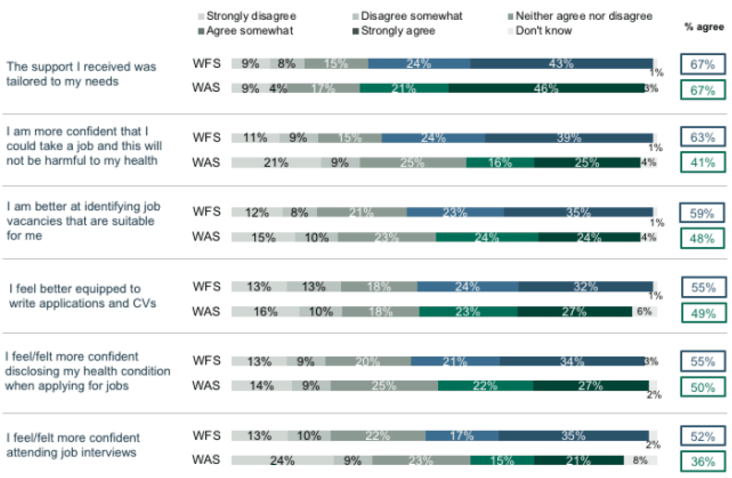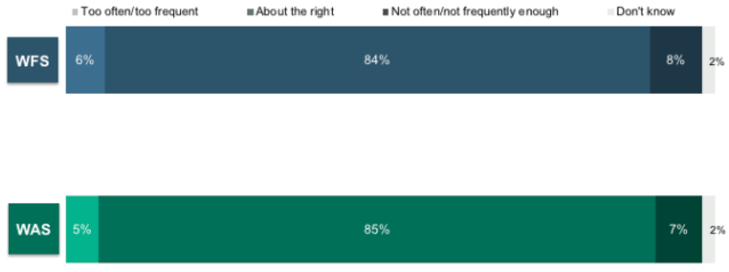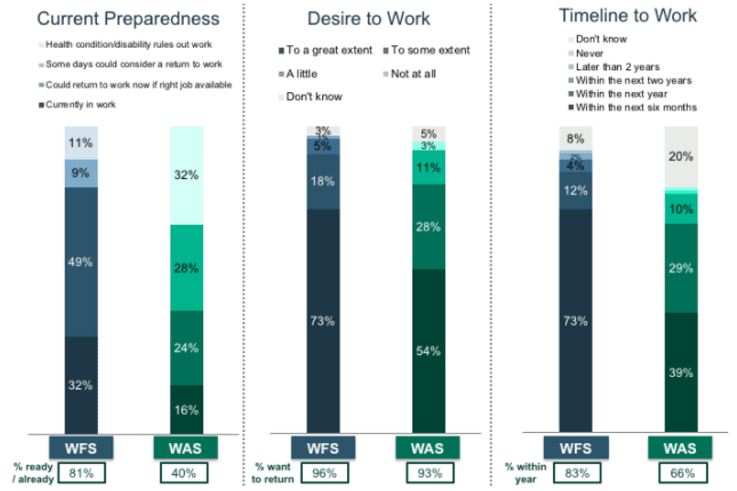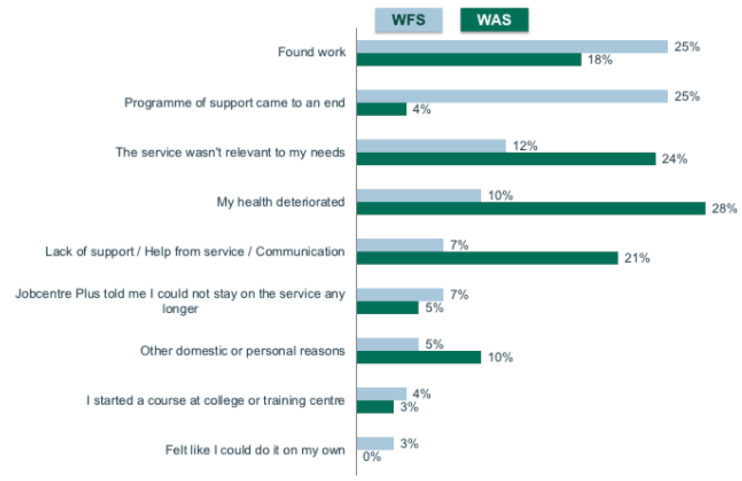Evaluation of Scottish transitional employment services: interim report August 2018
How programme design impacted the quality of delivery and customers’ experience of Work First and Work Able Scotland services in the first 6 months after launch.
WFS and WAS service outcomes
Introduction
This section presents the survey responses on the early outcomes for customers, covering their changing attitudes, motivation to work, perceptions of future employability and reasons for discontinuing support.
Key findings
- As a result of programme support, WFS customers are more confident that they can take an appropriate job and this will not harm their health, they are better able to identify suitable job opportunities and apply for them, be more confident in disclosing their health condition when applying and be more confident at interview.
- A quarter of WFS customers were in work at the time of the survey with a further 4% in training. Those in work may well include some who are working permitted hours (less than 16 hours per week) and so will not qualify as programme job outcomes. However, there are also indicators of the programme ending too soon and/or not catering to needs for some.
- WAS customers have greater needs and less recent employment experience on average and this is reflected in somewhat lower confidence levels, particularly in terms of the impact of the programme support on their confidence that they can work without affecting their health and in terms of attending job interviews.
- Almost a third of WAS customers (32%) believed that their disability or health condition ruled out work altogether. It is not clear whether they were referred and started on the programme before they were really ready and it contradicts the finding that the vast majority of customers on both programmes are highly motivated to find work. It is possible that more time on programme may improve their confidence or that other forms of specialist support are required.
- That said, almost one in five WAS customers (18%) were in work at the time of the survey and a further 3% in training.
- The desire to work is strong in both programmes with 96% of WFS and 93% of WAS customers wanting to return to work. Only 1% of WFS and 3% of WAS stated that they had no desire to work.
- Across both programmes, high motivation to work is closely linked to the impact their disability or health condition has on day-to-day life. Those clients whose disabilities or health conditions have a lower day-to-day impact and/or who feel able to manage their disability or condition saw the highest increases in their motivation to work.
Attitudes toward work search tasks
Customers (both current and previous) were asked the degree to which they agreed with a set of statements relating to how well the service performed in respect of offering tailored support, improving their confidence in their ability to return to work, helping to identify suitable opportunities, writing applications and CVs, and improving confidence to disclose their disability or health condition in applications and confidence in interviewing. Figure 5.1 shows the full results of these states for both services.
Figure 5.1 Service impact on job search tasks

Source: IFF Research Telephone survey of WFS and WAS customers
F1. To what extent do you agree or disagree with the following statements about the support you received?
Base: WFS (n=499), WAS (n=201)
WFS customers reported that their experiences on the programme to date had changed their capabilities in a number of ways:
- Just over two-thirds reported that the support had been tailored to their needs with fewer than one in five (17%) who did not think support was tailored. Those with 'high impact' disabilities or health conditions which they feel prevent them from working were most likely to disagree that the support was tailored to their needs. This does reflect the views of frontline advisers in providers that the service had limited specialist health and wellbeing support to offer.
- Some 63% felt that WFS support had improved their confidence in that they could work and this would not be detrimental to their health. Some 20% did not agree with this statement.
- WFS support has made a difference on approaches to job search tasks for people with a disability or health condition:
- 59% now considered that they were better able to identify vacancies that were suited to them
- A similar proportion were now better equipped to write applications and CVs, although over a quarter did not feel that this was the case for them
- More than half reported that they were now more confident that they could reveal their health condition when applying for jobs
- Almost two-thirds reported that they were now more confident attending job interviews as a result of WFS support. Those who have worked within the last two years are considerably more confident in interviewing and have higher certainty that work won't harm them. Discussions with employers did highlight that many WFS customers were prepared and came across well at interview.
For those in WFS, clients who received occupational therapy were more likely to agree to all these statements across confidence and skills. This suggests that the occupational therapy offer could be a key step to mentally support clients through this process.
Overall, those WFS customers most likely to have agreed to these statements are also more likely to have a condition that does not regularly impact them day-to-day and that they manage well. They are also more likely to feel ready to return to work for some or all days and have a high degree of motivation to do so. Indeed, many are already working at the time of survey.
WFS customers that had taken advantage of work experience opportunities exhibited higher levels of confidence in both disclosing their condition and thinking that work would not have a negative effect on their condition that others. Getting customers to the point where they have this confidence before going on work experience or job interviews may remain a challenge for some and explain the relatively high proportion of customers who do not agree that support had made them more confident in this regard.
For WAS customers, there is a different pattern of outcomes:
- Over two-thirds reported that the support had been tailored to their needs with 13% not agreeing with this statement.
- Around half the customers reported that:
- They were better able to identify vacancies that were suited to them (48%)
- They were better equipped to write applications and CVs (49%)
- They were now more confident that they could reveal their health condition when applying for jobs (50%)
However, only a minority reported that:
- They were confident that they could take a job and this would not be harmful to their health (41%). Almost a third disagreed with this statement.
- They were now more confident attending job interviews as a result of WAS support (36%) with a third saying that they were not more confident.
Confidence interviewing and taking jobs are the biggest areas of difference between the programmes, which may suggest that WAS clients remain furthest from the labour market, despite higher take-up of most services. There are too few WAS survey respondents to provide robust insight into why customers have lower levels of confidence about the potential harm work might cause to a condition but the data indicates that having relatively recent experience of employment is a factor.
The analysis of the characteristics of the WAS client group demonstrate that they have greater needs and are often more distant from recent employment. Discussions with frontline advisers in providers and the supply chain reinfrorce this view. It is also the case that frontline advisers felt that it takes longer to build trust and confidence with this group and this may explain why proportionately fewer are yet to report increased confidence in employment-related issues.
There were otherwise very few significant differences within or between the two client groups in terms of demographics and other factors.
Impact on levels of motivation
Clients were also asked the degree to which their motivation to find work has changed as a result of the programme. As shown in Figure 5.2 below, roughly two-third of clients in both programmes have an increased level of motivation following programme participation.
Figure 5.2 Change in motivation to work from using WFS/ WAS programme

Source: IFF Research Telephone survey of WFS and WAS customers
E9. To what extent, if any, would you say your motivation to find work has increased or decreased from when you began receiving support from WFS/ WAS?
Base: not currently in work and would like to work again at some point – WFS (n=344), WAS (n=170)
High motivation is closely linked to the impact their disability or health condition has on day-to-day life. Those clients whose disabilities or health conditions have a lower day-to-day impact and/or who feel able to manage their disability or condition, saw the highest increases in their motivation to work.
WAS clients who had occupational therapy were more likely to say their motivation increased as a result of being in the programme. Motivation increases for WFS clients who received occupational therapy is also higher, but not to a significant degree.
Expectations for future employment
Future prospects for employment is a crucial outcome for WFS and WAS customers, the survey explored their current preparedness to return to work, their desire to do so and their expected timeline for this to take place. Figure 5.3 below shows the results of these questions.
For WFS customers:
- Have a strong desire to secure employment, with just 1% reporting that they had no desire to secure employment. Almost three-quarters (73%) reported that they had a great desire to secure a job and a further 16% to some extent.
- Thirty-two percent of WFS clients are already in work and a further 49% feel ready to be. Some 11% believed that their current health condition ruled out employment.
- For those not yet working, 83% of WFS clients expect to return to work within the next year.
As noted earlier, WAS customers are expected to require longer term support before they become ready to return to work. At the time of the survey interview two in five said that they felt ready to return to employment. However, where they said that they were not yet ready, they were also more likely to say that they expect to be able to do so over a shorter timeframe.
In summary:
- WAS customer motivation is very high, with interest in returning to work at 93%. While only 3% say that they have no desire to return to work and more than half have a strong desire, over a third (35%) say 'to some extent' or 'a little'. In keeping with the above analysis of WAS impact on confidence, this suggests a significant minority of WAS customers remain less confident that employment is possible with their current health condition.
- In fact, almost a third of WAS customers (32%) believe that their disability or health condition rules out work altogether. At this stage of the research, it is not clear whether more time will build their confidence and trust or other forms of specialist support will make a difference to this perception.
- For those not yet working, two-thirds expect to return to work within 12 months and at the time of the survey 16% of WAS customers were already in work and a further 24% feel ready to start employment if the right job opportunity was available.
Figure 5.3 Impact on future employability factors

Source: IFF Research Telephone survey of WFS and WAS customers
E1. Which of the following is closest to how you feel about returning to work?/E2. To what extent would you like to return to work in the future?/E3. At what stage in the future do you think you will be able to work?
Base: WFS (n=499), WFS not currently employed (N=350), WAS (n=201), WAS not currently employed (N=174)
Reasons for leaving the programme
Those no longer receiving support from their programme were asked why they are no longer involved. These reasons for leaving the support service provide some insight into the operations of each. The results are presented in Figure 5.4.
Looking at WFS first, the reasons for leaving show a stronger degree of positive outcomes. One-in-four (25%) left the programme due to finding work [25] , while a further 4% went into training or education. However, there are also indicators of the programme ending too soon and/or not catering to the needs of some:
- For 32%, the programme ended before they found work, including a small proportion of customers (7%) who said that JCP told them they could not stay on the service [26]
- 12% did not find it relevant to their needs
- 7% felt the programme lacked support and communication, ultimately not being helpful
Notwithstanding the possibility that many of these customers were inappropriate referrals, this suggests that, while WFS has a strong level of positive outcomes during its initial period, the programme length may have been insufficient for others. Overall relevance of the programme could also be improved to ensure it meets client needs, which parallels the finding that the one-third felt the programme did not provide support tailored to their needs.
Figure 5.4 Reasons for leaving WFS/ WAS service

Source: IFF Research Telephone survey of WFS and WAS customers
D4. Why did you leave the support service? Only items with more than 2% shown. Order based on total scores
Base: those who are no longer receiving support – WFS (n=284), WAS (n=49)
Almost one in five WAS customers (18%) had found work and 3% started training. As with the WFS employment outcomes this may include a proportion of 'permitted work' jobs where customers work less than 16 hours and retain their benefits. Both WAS and WFS job outcomes need to be for more than 16 hours to trigger a job outcome payment. Those who have left for positive outcomes are similarly most likely to be least affected by their disability or health condition and been out of work less in recent years.
Reflecting a customer group with higher support needs, 24% felt the programme wasn't relevant to them and 21% said it lacked support and communication. Further, 28% had their health deteriorate whilst in the programme. Frontline advisers in providers and their supply chain did find maintaining customer participation a challenge, especially through rough patches or relapses. Encouragement and flexible responses were found to help a little but few had specialist support available to address these issues. More felt that peer group work and the encouragement of being alongside people in similar situations was as effective but customers needed a degree of confidence to access this level of support.
Some 9% of customers report that WAS support had come to an end or they were informed by JCP that they could no longer access the service. We think that as the programme had not run for the full 12 months of pre-support for any of these customers, these cases must be where they failed to attend for three or more meetings and so were exited from the programme.
Client outcomes
It must be stressed that these are early job outcomes – only those in the first month of recruitment to WFS in April will have reached their maximum 6 month participation by this stage (Oct 2017). Discussions with providers and the supply chain have suggested that job outcomes have been resilient as the programmes reach their conclusion. Many clients returned in the New Year keen to make a difference to their lives.
Comparisons with other programmes are never straightforward because of differences in client groups, definitions of performance measures and the availability of detailed performance data. However, in the case of WFS it is possible to compare to an extent against the performance of Work Choice. Data is only available for the programme as a whole and since November 2015 (when the short job outcome indicator changed to become a measure of all those who had been in work for 13 weeks). Short unsupported job outcomes for the programme as a whole were 16% for November to March 2015/16 [27] which is the most robust outcome measure available. A more contemporaneous measure is the simple proportion of starts who have achieved an unsupported job outcome – running at around 13.5% for the last three quarters of 2016/17.
Short unsupported job outcomes are for at least 16 hours a week and so they are not directly comparable to the proportion of WFS customers in the survey who were in work when the survey was conducted (nor do we know whether this employment has sustained for 13 weeks). However, this will be an important performance benchmark for WFS once employment outcomes have had time to mature.
The second phase of this evaluation will seek to explore employment outcomes and their sustainability more fully.
Contact
There is a problem
Thanks for your feedback